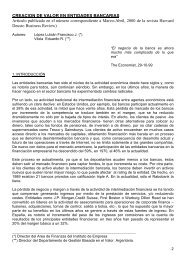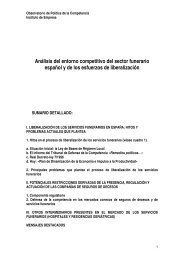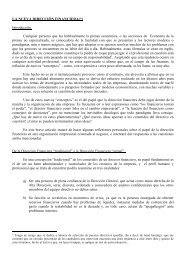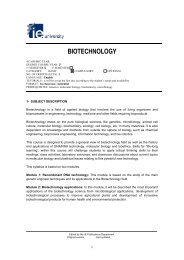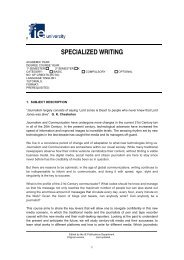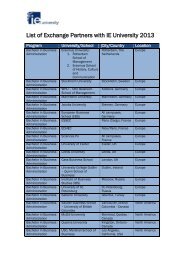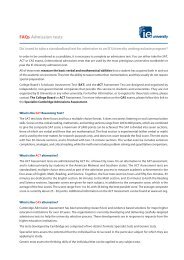CONTABILIDAD DE COSTES - IE
CONTABILIDAD DE COSTES - IE
CONTABILIDAD DE COSTES - IE
You also want an ePaper? Increase the reach of your titles
YUMPU automatically turns print PDFs into web optimized ePapers that Google loves.
<strong>CONTABILIDAD</strong> <strong>DE</strong> <strong>COSTES</strong><br />
OBJETIVOS<br />
Los principales objetivos a conseguir pueden resumirse en los tres siguientes:<br />
• Aportar una base de conocimientos de costes sólida, para ayudar al directivo en la toma<br />
de decisiones<br />
• Entender las relaciones existentes entre las operaciones de la empresa y los<br />
costes<br />
• Aprender a diseñar aquel sistema de costes que mejor interprete la realidad de la<br />
empresa y que más contribuya a la toma de decisiones<br />
METODOLOGÍA<br />
Se utilizará de forma importante el método del caso, acompañado en ocasiones por ejercicios<br />
más sencillos. La finalidad de los ejercicios es la comprensión del cálculo de los costes. Por el<br />
contrario los casos complementan este objetivo con una visión más amplia de los mismos con<br />
relación a la estrategia de la empresa.<br />
Asimismo, el programa se ve complementado por algunas conferencias interactivas entre el<br />
profesor y el alumno, en donde este último debe también exponer situaciones y ejemplos reales<br />
que ayuden a una mejor comprensión de los conceptos.<br />
Será también de vital importancia la presentación de los ejercicios y los casos por parte de los<br />
diferentes grupos de trabajo, para una mayor riqueza de las discusiones en clase.<br />
PROGRAMA<br />
I. INTRODUCCIÓN A LOS <strong>COSTES</strong><br />
SESIONES 1 y 2<br />
INTRODUCCIÓN A LA <strong>CONTABILIDAD</strong> <strong>DE</strong> GESTIÓN<br />
Objetivos de las sesiones:<br />
• Definir el papel de la contabilidad financiera, la contabilidad analítica y la contabilidad<br />
de planificación y control, evaluando la evolución del papel actual de la contabilidad de<br />
gestión<br />
1⏐
• Entender los costes dentro del contexto de la Cadena de Valor y del sistema de Valor de<br />
las empresas<br />
• Contabilidad de gestión y cadena de valor<br />
• Distinguir entre sistemas de costes y gestión de costes<br />
II. PROCESO <strong>DE</strong> ASIGNACIÓN <strong>DE</strong> <strong>COSTES</strong><br />
SESIONES 3 y 4<br />
ESTRUCTURA Y DISEÑO <strong>DE</strong> LOS SISTEMAS <strong>DE</strong> <strong>COSTES</strong>: SISTEMAS <strong>DE</strong> <strong>COSTES</strong> POR<br />
PEDIDO: EL PROCESO <strong>DE</strong> ASIGNACIÓN <strong>DE</strong> <strong>COSTES</strong> INDIRECTOS; SISTEMAS V.B.C.<br />
Objetivos de las sesiones:<br />
• Etapas del proceso de asignación de costes.<br />
• Centros de coste de producción y centros de coste de servicio<br />
• Relaciones entre el sistema operativo y los costes<br />
• La medida de recursos y la medida de actividad<br />
• Tratamiento y determinación de los volúmenes de actividad<br />
SESIONES 5 y 6<br />
ESTRUCTURA Y DISEÑO <strong>DE</strong> LOS SISTEMAS <strong>DE</strong> <strong>COSTES</strong> (III): EL PROCESO <strong>DE</strong><br />
ASIGNACIÓN <strong>DE</strong> <strong>COSTES</strong> INDIRECTOS: SISTEMAS A.B.C.<br />
Objetivos de las sesiones:<br />
• Explicar y comprender por qué los sistemas tradicionales de costes (sistemas<br />
V.B.C.) tienden a distorsionar el coste de los productos.<br />
• Hacer una introducción de los sistemas de costes A.B.C. comparándolos con los<br />
sistemas V.B.C.<br />
• Calcular el coste de un producto por ambos sistemas, comparando los resultados<br />
obtenidos y tratando de comprender y explicar los resultados obtenidos.<br />
III ESTRATEGIA Y <strong>COSTES</strong><br />
SESIÓN 7<br />
EL DISEÑO <strong>DE</strong> UN SISTEMA <strong>DE</strong> <strong>COSTES</strong> EN FUNCIÓN AL ENTORNO Y LA ESTRATEGIA<br />
Objetivos de la sesión:<br />
• Estudiar los elementos a tener en cuenta para el diseño de un sistema de costes<br />
• Desarrollar los pasos necesarios para el diseño del mismo<br />
• Comprender el encaje necesario entre la estrategia del negocio y el sistema de costes<br />
• Estudiar el encaje entre el sistema de costes y las distintas tomas de decisiones<br />
SESIÓN 8<br />
Objetivos de la sesión:<br />
• Resumen de los conceptos analizados hasta ese momento<br />
• Tipos de costes<br />
2⏐
• Imputación de costes:<br />
– VBC<br />
– ABC<br />
• Ventajas e inconvenientes de cada método<br />
SESIÓN 9<br />
TARGET COSTING: SISTEMAS <strong>DE</strong> <strong>COSTES</strong> OR<strong>IE</strong>NTADOS AL MERCADO<br />
Objetivos de la sesión:<br />
• Explicar y entender el modelo de target costing<br />
• Aprender a trabajar los costes desde la vertiente del mercado<br />
• Relacionar el target costing con los objetivos de mejora continua y otras herramientas<br />
SESIONES 10 y 11<br />
LOS SISTEMAS <strong>DE</strong> <strong>COSTES</strong> ESTÁNDAR (I)<br />
Objetivos de la sesión:<br />
• Entender el establecimiento del coste estándar y del modelo de costes estándar<br />
• Aprender a calcular las desviaciones de costes estándar<br />
• Desviaciones en costes directos<br />
• Desviaciones en gastos generales de fabricación<br />
• Análisis de las desviaciones en volumen, eficiencia y gasto<br />
• Interpretar las desviaciones<br />
• Comentar determinadas herramientas de costes para el establecimiento de unos<br />
buenos estándares<br />
IV <strong>DE</strong>CISIONES <strong>DE</strong> EXPLOTACIÓN<br />
SESIONES 12 (Videoconferencia)<br />
EL MO<strong>DE</strong>LO COSTE-VOLUMEN-BENEFICIO<br />
Objetivos de la sesión:<br />
• Clasificar y entender los diferentes tipos de decisiones de explotación: decisiones<br />
de inversión y decisiones de explotación: decisiones de precio y decisiones de producto.<br />
• Entender el modelo coste-volumen-beneficio.<br />
• Entender el concepto de Margen de Contribución Unitario y Total.<br />
• Distinguir margen bruto y margen de contribución, toma de decisiones con cada uno.<br />
• Determinar el punto de equilibrio y su aplicación a las empresas multiproducto<br />
• Identificar las hipótesis y limitaciones del modelo C-<br />
V-B.<br />
SESIONES 13 y 14<br />
RECAPITULACIÓN <strong>DE</strong> TODOS LOS CONCEPTOS <strong>DE</strong> LA MATERIA IMPARTIDOS<br />
3⏐
SESIÓN 15<br />
EXAMEN FINAL<br />
SISTEMA <strong>DE</strong> EVALUACIÓN<br />
• Presentación grupos de trabajo 30 %<br />
• Participación en clase y foros 40 %<br />
• Examen final 30 %<br />
4⏐
COST ACCOUNTING<br />
COURSE <strong>DE</strong>SCRIPTION<br />
A cost accounting system collects and classifies costs and assigns them to cost objects. The<br />
goal of a cost accounting system is to measure the cost of designing, developing, producing (or<br />
purchasing), selling, distributing, and servicing particular products or services. Cost allocation is<br />
at the heart of most accounting systems. Cost behavior -how the activities of an organization<br />
affect its costs- is also fundamental to cost accounting systems. The data provided by a cost<br />
accounting system is used for various purposes, which include product costing, planning and<br />
control, and decision making. This course mainly focuses on the first of these objectives -<br />
products costing.<br />
COURSE GOALS<br />
Students, as future managers, will utilize, at a minimum, the output of cost systems, which are<br />
the primary internal information systems in a firm. Students taking this course will gain an<br />
understanding of cost accounting systems, which includes a familiarization with: the goals of<br />
cost accounting systems; the fundamental features and design of cost accounting systems; and<br />
the various uses of the data provided by cost accounting decisions.<br />
A sound understanding of these issues is necessary to interpret cost accounting system<br />
outputs; to transform them from data to information and knowledge. Without this understanding,<br />
cost accounting data is often mis-interpreted and/or mis-applied leading to erroneous decision<br />
making.<br />
<strong>DE</strong>TAILED COURSE SCHEDULE<br />
The course schedule is as follows:<br />
SESSION 1<br />
PRESENTATION<br />
• Course overview, policies, and grading<br />
• The need for managerial accounting<br />
• Elements of management control<br />
• Costs, benefits and context<br />
• New management themes around the globe<br />
5⏐
SESSIONS 2 & 3<br />
• General cost classifications<br />
• Direct vs. indirect costs<br />
• Cost drivers and cost management<br />
• Cost classification for cost behavior<br />
• Total costs and unit costs<br />
• Manufacturing costs<br />
SESSIONS 4 & 5<br />
• The building block concept of costing systems<br />
• Job costing and process costing<br />
• Job-order costing in manufacturing<br />
• Job-order costing- normal costing<br />
• Budgeted indirect costs.<br />
SESSION 6<br />
• Purpose of cost allocations<br />
• Cost-benefit issues and other contextual factors<br />
• Allocating costs from one department to another<br />
SESSION 7<br />
• Denominator level capacity concepts<br />
• Fixed capacity analysis<br />
• Downward demand spiral<br />
SESSIONS 8, 9, & 10<br />
• Undercosting and overcosting<br />
• Product cost cross-subsidization<br />
• Refining a cost system<br />
• Activity-Based-Costing (ABC)<br />
• Cost hierarchies<br />
• Traditional vs ABC approach to designing a cost system<br />
SESSION 11 & 12<br />
• Strategic and Operating Plans<br />
• Master Budget and its components<br />
• Budget Cycle<br />
• Behavioral Considerations<br />
• Profit Plans<br />
6⏐
SESSION 13<br />
• Overview of variable and absorption costing<br />
• Capsule comparison of stock costing methods<br />
• Performance measures and absorption costing<br />
• Effect on financial statements<br />
SESSION 14 & 15<br />
• Revenue and cost drivers: general case and specific case<br />
• Cost-Volume-Profit (CVP) assumptions<br />
• The breakeven point (BEP)<br />
• The PV graph<br />
• Sensitivity analysis and uncertainty<br />
• Cost planning and CVP<br />
• Effects of sales mix on profit<br />
• Role of income taxes<br />
• Contribution margin and gross margin<br />
• Breakeven point and NPV<br />
SESSIONS 16 & 17<br />
• Information and the decision process<br />
• The meaning of relevance<br />
• Illustration of relevance<br />
• Insourcing vs. outsourcing and make-vs-buy<br />
• Sunk costs, outsourcing and capacity constraints<br />
• Relocation decisions<br />
SESSION 18<br />
• Target costing and target pricing<br />
• Value engineering<br />
SESSION 19<br />
• Customer profitability analysis<br />
• Benchmarking.<br />
SESSION 20<br />
FINAL EXAM<br />
7⏐
COURSE ORGANIZATION<br />
Student work groups are expected to have the required problems and cases prepared in<br />
electronic format (i.e., word, excel, etc) and will be called upon to present and participate in the<br />
discussion of the solutions.<br />
EVALUATION COMPONENTS<br />
• Class participation: approx. 25% of total grade.<br />
• Final exam: approx. 75% of total grade.<br />
EVALUATION CRITERIA<br />
Class participation: Attendance and participation is a critical part in forming a dynamic learning<br />
experience. I expect from you an active leadership on this. Your willingness to share your views<br />
with the class and the quality of your comments will count towards your class participation.<br />
Furthermore, I will administer some quizzes during the course without previous notice. It will be<br />
up to you to return the completed questionnaires to me or not to. Poor performance in such<br />
quizzes will not count negatively towards your class participation but I will grade positively those<br />
students doing well on such tests. On the other hand, I will count negatively towards your<br />
participation a disturbing attitude in class (e.g., unnecessary connections to the Internet,<br />
chatting, SMS, etc).<br />
Final exam: The final examination is comprehensive and will test your understanding of the<br />
nineteen sessions that comprise the course. The exam will predominately consist of similar<br />
questions, cases and problems to those worked in class (also see below).<br />
Materials related to your class evaluation (e.g., participation, exams) will be available for review<br />
in my office towards the end of the term. However, due to the large volume of such requests, it<br />
is highly advised to set up an appointment in advance to receive due consideration of your<br />
request.<br />
RESOURCES FOR SELF-ASSESSMENT AND IMPROVEMENT<br />
During the middle of the course (i.e., somewhere around session 9-11), each student will be<br />
provided feedback of their class participation performance, which would be inclusive of all the<br />
previous classes. This feedback will provide you an opportunity to take necessary steps to<br />
further improve your participation.<br />
After concluding ABC systems (Session 10), a practice exam will be made available. I highly<br />
encourage that you take some time to solve it. However, you are not required to hand-in this<br />
exam. The purpose of the “exam” is to provide you with a self-evaluation tool. More importantly,<br />
the structure of the practice exam will closely follow the final exam. Hence, it will provide you<br />
with an idea of the type of questions as well as the time that you should allocate for each part of<br />
the test. The exam will also contain information regarding the point’s distribution between<br />
questions and short cases. About one week after posting the practice exam, the solution to<br />
questions and cases will be made available, which will enable you to grade your exam as well.<br />
8⏐


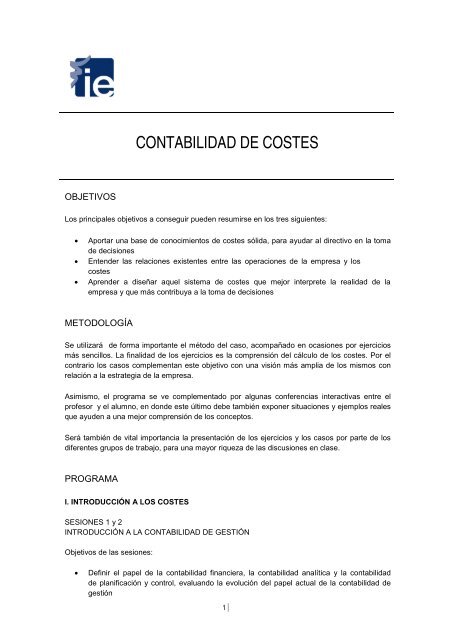
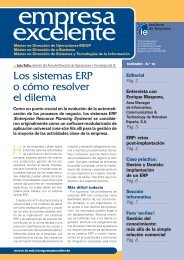
![Change Management Workshop Program Brochure[pdf] - IE](https://img.yumpu.com/22502183/1/184x260/change-management-workshop-program-brochurepdf-ie.jpg?quality=85)
